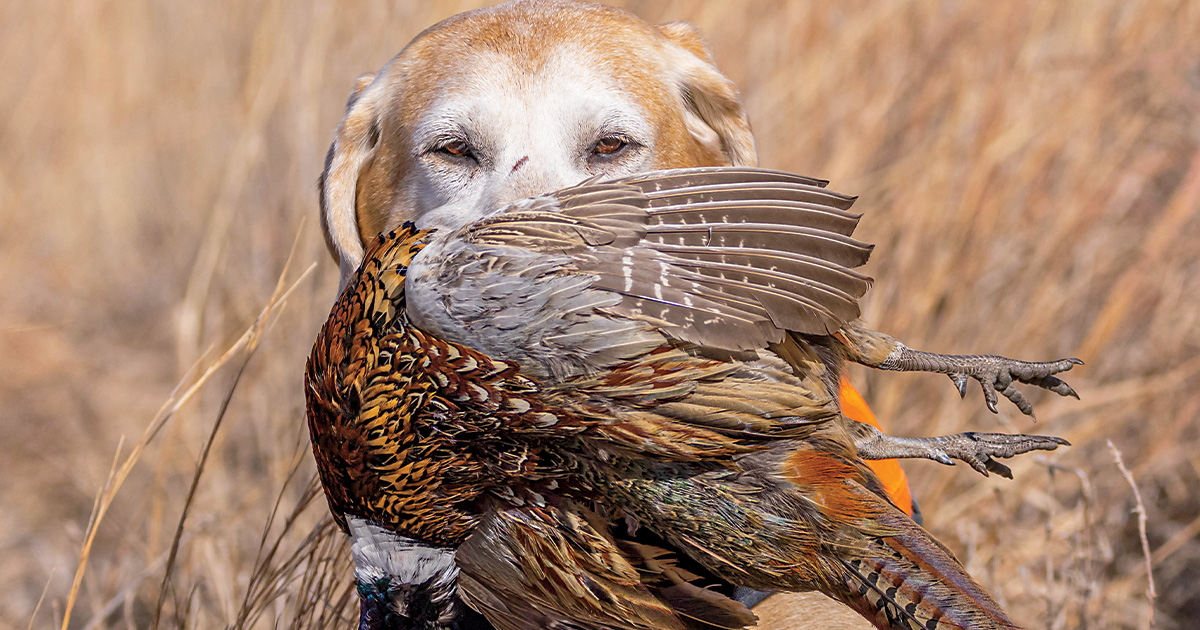Retrievers: Double-Duty Dogs
With proper training, your retriever can become an enthusiastic upland hunter
With proper training, your retriever can become an enthusiastic upland hunter


An experienced waterfowl retriever already knows how to use his nose to find ducks and geese. Training him to hunt upland birds expands on that skill through exposure to new environments and hunting situations.
Virtually any dog with the drive and desire to retrieve waterfowl has the right stuff to hunt upland birds, and it’s typically not so much a matter of teaching them how as it is simply putting them in situations where their instincts can take over and then rewarding them for the behavior.
For professional trainer John Luttrell, whose kennels in east-central South Dakota are in prime territory for both ducks and pheasants, double-duty dogs are the rule rather than the exception.“Probably 75 percent of the dogs I get for training will be expected to bounce back and forth between waterfowl hunting and pheasant hunting,” he says. “And my experience is that dogs are always better at one than the other. Some of this has to do with genetics and the personality of the individual dog. Some of it has to do with how the dog was started. A dog that starts out as a duck hunter, where steadiness is emphasized, will often be hesitant to ‘loosen up’ and hunt really hard in the uplands, while a dog that starts out pheasant hunting can be hard to bring under the kind of control you need to hunt ducks and geese.”
Note that we’re talking here about the classic retrieving breeds, not about pointing Labs or any of the versatile pointing breeds. They can make terrific double-duty dogs, but the pointing component makes their training more specialized.
The ideal scenario is to weave upland work into your retriever training program. Luttrell does this with young dogs, five months of age or so, by playing hide-and-seek. He scatters several dead pigeons roughly 30 yards apart in a field, clips a 50-foot rope to the dog’s collar, and, after starting with the sit command, says “Hunt ’em up!” Then, walking into or across the wind and not saying anything, he simply lets the pup wander around, dragging the rope, until his nose leads him to a bird.
“That’s a huge reward for a young dog,” Luttrell says. “A pigeon’s an easy bird for a five-month-old puppy to pick up. After playing the game three or four times, they’re not looking at you anymore; they’re hunting.”
At this stage, Luttrell doesn’t walk back and forth in an effort to get the pup to do the same. “I’m not trying to instill a spaniel-like windshield-wiper pattern,” he explains. “I’ll help if necessary by steering the dog toward the bird, but I do as little of that as possible. I want to let the dog do his own thing and be successful without depending on me to find the birds for him. I want him relying on his instincts.”
Once the pup has gained some confidence and is hunting on his own, Luttrell gradually transitions to using live birds. He also begins using the rope as a teaching tool. When the dog reaches the end of the rope, he’ll give him a bump—no more than that—along with two toots on the whistle. “It just means ‘come closer,’” Luttrell explains, “not ‘come all the way in.’ That’s five or more toots.”
From there, he gradually replaces the rope with an e-collar—but only when he’s satisfied that the pup is hunting hard and freely, maybe even pushing gun range a little. “I’d rather see a dog pushing gun range,” he insists, “than sticking too close.”
For an older waterfowl dog that hasn’t hunted upland birds, the process is much the same. After salting a field with birds, Luttrell says “Hunt ’em up!” and takes the dog for a walk. Eventually the dog will smell a bird, his instincts will kick in, and he’ll go for it.
“That dog knows how to use his nose to find birds,” Luttrell observes, “so in a way it’s just a change of venue. But if the dog’s been taught to not leave his master’s side until he’s sent for a retrieve, he’s bound to be a little confused. It’s almost as if you’re asking him to unlearn his training. Some dogs pick it up faster than others. You have to be patient and give him the time and the repetitions he needs to figure it out.”
Ducks Unlimited uses cookies to enhance your browsing experience, optimize site functionality, analyze traffic, and deliver personalized advertising through third parties. By continuing to use this site, you agree to our use of cookies. View Privacy Policy